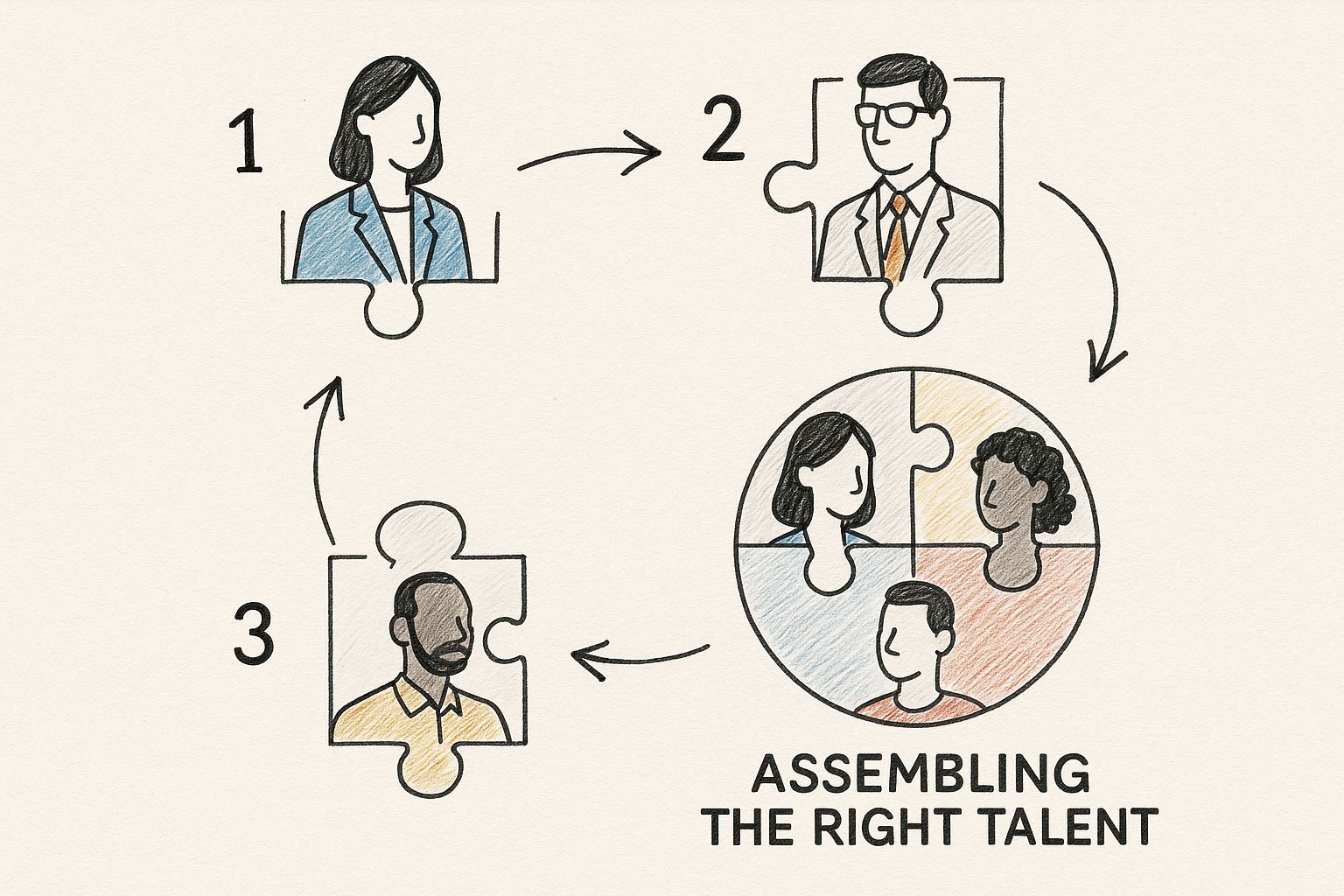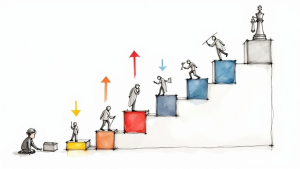Table of Contents
The simple answer is you need to cultivate an environment built on three core pillars: psychological safety, a clear shared purpose, and mutual accountability. This isn't about just hiring the smartest people you can find; it's about engineering a system where their collaboration actually sings.
The Blueprint for a High-Performing Team
Most leaders start their quest for a high-performing team by focusing on résumés and individual skills. While talent obviously matters, it's just the entry ticket. The real, challenging work lies in architecting the interactions between those talented people. This guide is your playbook—we're moving past abstract theories to give you a structured, actionable framework that gets results.
The foundation of any elite team isn't raw intelligence or years of experience. It's something far more human.
It all starts with a culture of psychological safety. This is the bedrock. It's the shared belief that team members can take risks, voice off-the-wall ideas, or admit a mistake without getting shut down or blamed. Everything else is built on this.
The Core Components of Team Excellence
True high performance really only shows up when a few specific cultural and structural elements click into place. Think of these as the must-have ingredients you need to get right.
- A Clear, Shared Purpose: Every single person on the team needs to understand and genuinely buy into the "why" behind the work. This shared vision is what aligns all the individual efforts and keeps people motivated when things inevitably get tough.
- Mutual Accountability: This is not about the manager cracking the whip. It’s about teammates holding each other to a high standard because they have a shared commitment to the outcome. It's a "we're in this together" mindset.
- Defined Roles and Responsibilities: Clarity is king. When everyone knows exactly what their role is and how it plugs into the bigger picture, it kills confusion and territorial disputes. People can then operate with confidence and autonomy.
This isn't just fluffy talk; it's backed by some serious research. When Google analyzed 180 of its own teams in its famous Project Aristotle, it found that the dynamics of how a team works together matter far more than who is on the team. Psychological safety came out on top as the single most critical factor.
Ready to drive more growth & achieve bigger impact?
Leverage my 25+ years of successes and failures to unlock your growth and achieve results you never thought possible.
Get StartedTo give you a clearer picture, here’s a breakdown of what these pillars look like when you put them into practice.
Core Pillars of a High Performance Team
| Pillar | What It Means in Practice | Key Leadership Action |
|---|---|---|
| Psychological Safety | Team members feel safe to be vulnerable, admit mistakes, and challenge ideas without fear of retribution. | Model vulnerability yourself. Actively solicit dissenting opinions and thank people for them. |
| Clear Shared Purpose | Everyone on the team can articulate the "why" behind their work and understands how it connects to the larger mission. | Constantly reiterate the mission. Connect daily tasks back to the big-picture goals. |
| Mutual Accountability | Peers hold each other to high standards, giving direct and constructive feedback because they share a goal. | Create transparent goals and progress trackers. Foster a culture where feedback is seen as a gift. |
Getting these pillars right creates a solid base for everything that follows. It's what turns a group of individuals into a cohesive unit.
The ultimate competitive advantage lies in a team's ability to learn and adapt together. Building this capacity starts with laying the right foundation—one of trust, clarity, and shared ownership.
This guide will walk you through the nitty-gritty of constructing this foundation. From designing your team’s strategic framework to fostering the daily rhythms that reinforce engagement, you'll get the tools to build a team that consistently crushes its goals.
For a deeper look at the foundational principles, there are some proven strategies for building strong teams that are well worth exploring.
Designing Your Team's Strategic Framework
A truly high-performing team doesn't just happen. It’s architected with intention. This is where you move past the abstract idea of a "great team" and get into the practical, nitty-gritty work of building one. It’s about creating a solid blueprint for success before the first task is even assigned.
Ready to drive more growth & achieve bigger impact?
Leverage my 25+ years of successes and failures to unlock your growth and achieve results you never thought possible.
Get StartedWithout this blueprint, even the most talented people can drift. You end up with confusion, duplicated effort, and a frustrating lack of real ownership. A solid framework ensures every action and decision is aligned and purposeful.
Crafting a Compelling Team Purpose
The first, most critical piece is defining a compelling team purpose that hooks directly into the company's bigger mission. This isn't just about a project goal; it's the "why" that fuels motivation when things get tough. Every single person on the team should be able to articulate not just what they do, but why it matters.
A software team's purpose isn't just "to ship code." That's flat. A much more powerful purpose would be, "to build intuitive tools that save our customers 10 hours a week, freeing them up for more creative work." Now that's a mission. It reframes every task and connects daily work to a tangible, human impact.
A team without a purpose is like a ship without a rudder. It might be moving, but it's not heading toward a deliberate destination. The purpose statement is your North Star, guiding all subsequent decisions about roles, processes, and priorities.
Defining Roles With Absolute Clarity
Once you know your "why," the next layer is defining roles and responsibilities with surgical precision. Ambiguity is the enemy of performance. I’ve seen it time and again: when roles are fuzzy, tasks get dropped, ownership is a mystery, and people inadvertently step on each other's toes.
A classic tool for this is a RACI chart (Responsible, Accountable, Consulted, Informed), but you can often get by with a simpler approach for most teams:
- Owner: The one person ultimately on the hook for a specific outcome.
- Contributor: The people actively doing the work in that area.
- Advisor: The folks you need to consult before making a key decision.
Ready to drive more growth & achieve bigger impact?
Leverage my 25+ years of successes and failures to unlock your growth and achieve results you never thought possible.
Get StartedThis clarity doesn’t just prevent confusion; it empowers people. When someone knows exactly what they own, they feel a greater sense of autonomy and accountability. It’s a cornerstone of building a team that doesn't need constant hand-holding.
This visual really drives home how different professional talents, like puzzle pieces, come together to form a cohesive unit.

The key takeaway here is that peak performance relies on how well you integrate these diverse skills—it’s not just about having talented individuals in the same room.
Optimizing Team Composition and Size
The final piece of your strategic framework is getting the right mix of people on the bus. This goes way beyond just looking at technical skills on a resume. You need to think about cognitive diversity—bringing in different thinking styles, problem-solving approaches, and perspectives. The data backs this up. Research from Gartner shows that cognitively diverse teams can outperform their peers by as much as 12%.
But size is just as critical. It might seem like more people equals more brainpower, but I’ve found that team effectiveness nosedives once you get too big. Teams with more than ten people often get bogged down in communication overhead and start forming cliques.
From my experience, the sweet spot for maximizing communication, cohesion, and individual accountability is between three and nine members. If you want to dig deeper into the data, there are some great teamwork statistics at runn.io that explore this further.
Fostering a Culture of Psychological Safety

If a team’s strategic framework is its skeleton, then psychological safety is its central nervous system. It's the invisible force that determines whether a team just gets by or actually becomes great.
This isn’t about being “nice” to each other. It’s the shared, unspoken belief that you can take risks. It means you can challenge a popular idea, question a decision, or admit you screwed up without fearing you’ll be shamed or punished for it.
Ready to drive more growth & achieve bigger impact?
Leverage my 25+ years of successes and failures to unlock your growth and achieve results you never thought possible.
Get StartedWithout this foundation, even the most talented people will play it safe. They'll keep brilliant but unproven ideas to themselves. They'll hide small mistakes that later blow up into huge problems. And they'll shy away from the healthy, necessary friction that pressure-tests strategies and makes them stronger.
The Leader’s Role in Modeling Vulnerability
Psychological safety doesn't just happen. It's built, brick by brick, through deliberate actions—and it has to start with the leader. Your behavior sets the tone. Period.
The most powerful thing you can do? Be vulnerable yourself.
When you admit you don’t have all the answers, share a story about a past mistake, or just say you're uncertain about the best path forward, you give everyone else permission to be human, too. This isn't weakness. It’s a sign of confidence—confidence in your team's ability to figure it out together.
Instead of saying, "Here's the plan, now go execute," try a small shift in language: "Here's my initial thinking on this, but I'm not 100% sure it's the right move. What am I missing? Where are the holes?"
That simple change turns a directive into a genuine invitation to collaborate.
Turning Conflict into a Constructive Force
A lot of teams confuse politeness with harmony and avoid conflict at all costs. But high-performing teams know how to use disagreement as a tool for making better decisions. The trick is to frame conflict as a debate over ideas, not a battle between people.
Ready to drive more growth & achieve bigger impact?
Leverage my 25+ years of successes and failures to unlock your growth and achieve results you never thought possible.
Get StartedTo get there, you need to set some ground rules for productive debate:
- Attack the idea, not the person. Make it crystal clear that all critiques are aimed at the strategy or the process, never the individual who proposed it.
- Assume positive intent. Encourage everyone to start from the belief that you're all on the same side, even if you have different ideas on how to get there.
- Seek to understand, not to win. The point of a debate isn't to prove you're right. It's to collectively find the best possible answer. Active listening is everything.
A team that can’t disagree productively can’t innovate. Psychological safety creates an environment where intellectual friction generates light, not heat, pushing ideas from good to great.
This kind of environment is a non-negotiable part of a healthy team. For a deeper dive, our post on how to improve team culture offers practical strategies that feed directly into these principles.
Reframing Failure as Data
In a psychologically safe culture, failures aren't career-ending moments. They’re just data. When a project misses its mark or an experiment fails, the first question shouldn't be, "Whose fault is this?" It needs to be, "What did we learn?"
This shift is crucial for encouraging smart risk-taking. If people get punished for well-intentioned failures, they'll quickly learn to only chase safe, predictable, and usually far less ambitious goals.
A great way to make this real is with blameless post-mortems. When something goes wrong, get the team together to analyze what happened objectively. Keep the focus on the process, the system, and the decisions made—not on pointing fingers. By doing this, you turn a painful event into a powerful learning experience that makes the whole team smarter and more resilient for the next challenge.
Ready to drive more growth & achieve bigger impact?
Leverage my 25+ years of successes and failures to unlock your growth and achieve results you never thought possible.
Get StartedA brilliant strategy and a safe culture are essential, but they don't sustain themselves. High-performing teams run on a reliable operating system—a set of consistent rhythms and routines that weave engagement and accountability directly into how they work.
This isn't about jamming more meetings onto the calendar. It’s about designing intentional touchpoints that keep everyone aligned, informed, and pulling in the same direction. Without this structure, momentum gets squishy, and even the most motivated teams can drift apart.
Designing Your Communication Cadence
First things first: you need a predictable communication cadence. This is how you make sure information flows freely and avoid the soul-crushing "meeting overload" that everyone hates. The goal is to create a mix of high-touch and low-touch interactions, each with a crystal-clear purpose.
A simple, battle-tested model could look like this:
- Daily Huddles: A quick, 15-minute standing meeting (virtual or in-person) focused purely on progress and blockers. The point is alignment, not deep problem-solving.
- Weekly Tactical Meetings: A one-hour session to review progress against weekly goals, wrestle with specific challenges, and coordinate the game plan for the week ahead.
- Monthly Strategic Check-ins: A chance to zoom out and look at the bigger picture. Are we on track with our quarterly goals? What have we learned, and what adjustments do we need to make?
- Quarterly Reviews: Time to celebrate wins, run retrospectives on what worked (and what flopped), and set clear, hard priorities for the next quarter.
This kind of structure kills ambiguity. It creates a predictable flow that lets the team focus on the work, not on figuring out when the next update is.
Don't mistake motion for progress. A well-designed communication rhythm ensures every meeting has a purpose, moving the team forward instead of just keeping them busy. It's the difference between a chaotic scramble and a coordinated march toward a goal.
Making Feedback a Continuous Loop
Annual performance reviews are a relic. If you want to build a high-performing team, feedback can't be some yearly event; it has to be a continuous, multi-directional flow. It needs to be timely, specific, and feel like coaching, not criticism.
This isn't just about managers giving feedback to their reports. It's about building a culture where peer-to-peer feedback is normal, encouraged, and valued. That's how you get real, shared accountability. Strong technical leadership skills are non-negotiable here, as leaders have to coach their teams on how to deliver feedback that is both direct and empathetic.
The data on this is overwhelming. Gallup's research shows that teams with top-quartile engagement see a 23% jump in profitability and an 18% increase in sales productivity. The study found that managers are responsible for 70% of the variance in team engagement, which really hammers home the power of regular coaching and involvement. You can discover more about Gallup's findings on high-performing teams and the science behind their success.
Celebrating Small Wins and Delegating with Trust
Accountability isn't something you can mandate from the top down. It's a shared commitment you have to nurture over time. Two behaviors, in particular, really speed this up: celebrating progress and delegating with genuine trust.
Celebrating small wins is non-negotiable for morale. Seriously. When a team member squashes a tough bug, closes a small deal, or gets a rave review from a customer, call it out. Make it public. This reinforces the exact behaviors you want to see and shows people that their daily grind is noticed and valued. To really nail this, especially with remote teams, it's worth implementing some top remote employee engagement ideas to foster connection.
Ready to drive more growth & achieve bigger impact?
Leverage my 25+ years of successes and failures to unlock your growth and achieve results you never thought possible.
Get StartedFinally, great leaders empower their teams by delegating outcomes, not tasks. Instead of prescribing every single step, define the "what" and the "why," then trust your team to figure out the "how." That act of trust is an incredible motivator. It tells them you have confidence in their abilities, fostering the kind of ownership that is the true hallmark of an accountable, high-performing team.
Measuring Performance and Fueling Improvement
You can't improve what you don't measure. That’s a given. But so many teams get this wrong. They drown themselves in data, turning metrics into a tool for micromanagement instead of a compass for growth.
The best teams I’ve worked with are data-informed, not data-driven into the ground. They use numbers to spark conversations about where the real bottlenecks are and where the biggest opportunities lie. It’s a subtle but critical difference.
This means getting beyond simplistic output numbers. Counting "widgets produced" or "tickets closed" has its place, but it only tells you a fraction of the story. To really understand what’s happening, you need to look at a more balanced set of indicators.
Selecting Metrics That Actually Matter
For a truly holistic view, your metrics need to cover three key areas: Outcomes, Process Health, and Team Well-being. This combination creates a much more realistic—and useful—picture of your team's performance.
- Outcome Metrics (The "What"): These are your results. They reflect the actual value your team delivers to customers or the business. Think customer satisfaction scores (CSAT), net promoter score (NPS), or the revenue your work generates.
- Process Metrics (The "How"): These show you how efficiently your team’s workflow is running. This is where you track things like cycle time (from starting a task to delivering it), lead time, or your defect rate.
- Team Health Metrics (The "Who"): I see these as leading indicators of future performance. They measure things like engagement, psychological safety, and morale. You can get a bead on this with short, regular pulse surveys asking about workload or how supported people feel.
The idea here is to create a simple, visual dashboard that pulls a few key metrics from each of these categories. This isn't a weapon for assigning blame. It's a shared tool for spotting trends and, most importantly, asking better questions.
A dashboard that only tracks output is like driving a car by only looking at the speedometer. You know how fast you're going, but you have no idea if the engine is overheating or you're about to run out of fuel.
This balanced approach stops a team from hitting their output targets while burning out or racking up technical debt. That’s a classic recipe for long-term failure.
The Power of Continuous Reflection
Data on a dashboard is useless without dedicated time to reflect and adapt. This is where the magic of the team retrospective comes in. A retrospective is just a structured meeting where the team pauses to look back on a recent chunk of work and decide on concrete ways to get better.
This isn't a complaint session. A good retrospective answers three simple questions:
- What went well that we should keep doing?
- What didn't go so well?
- What could we try differently next time?
This simple framework creates a powerful, continuous improvement loop. It hands ownership of the process back to the team, empowering them to solve their own problems. Holding these regularly—every two weeks is a good rhythm—builds a habit of adaptation that is essential for any high-performing team.
Ready to drive more growth & achieve bigger impact?
Leverage my 25+ years of successes and failures to unlock your growth and achieve results you never thought possible.
Get StartedFreeing up your team from routine tasks can also create more space for these high-value improvement activities. For anyone looking to get more efficient, exploring the power of automation tools for boosting team efficiency can be a total game-changer.
From Measurement to Action
Here’s the final, crucial step: turning those insights into action.
Every retrospective needs to end with a clear, small, and actionable improvement the team commits to trying. Without this commitment, the whole exercise becomes performative and quickly loses its value.
For example, if the team realizes that fuzzy requirements are slowing them down, the action item isn't a vague "improve requirements." It's "for the next two weeks, we will ensure every new task has a clear 'Definition of Ready' checklist attached before we start work."
This cycle—measure, reflect, adapt—is the engine that powers continuous improvement. It turns data from a report card into a playbook, giving your team the tools they need to evolve and consistently perform at their best.
Navigating Common Team Challenges
Building a high-performing team is never a clean, straight line. Even with the best playbook and a killer culture, you’re going to hit roadblocks. That’s just part of the game. The real skill isn't in avoiding these challenges—it's in developing the muscle to navigate them, turning that friction into fuel for growth.
Every leader eventually runs into a few classic, tough scenarios. Most of them boil down to interpersonal conflict, motivation that’s started to wane, or a sudden change in strategy that throws everyone off balance. These moments are the true tests of your leadership and your team’s character.
Mediating Constructive Conflict
One of the trickiest situations is managing conflict between two talented, strong-willed people. It happens all the time. Imagine two of your best engineers are at a stalemate over an architectural decision. One is arguing for long-term scalability, while the other is laser-focused on shipping fast. Both have good points, but the debate has gotten personal, and you can feel the tension spreading.
Your job isn't to play referee or pick a winner. It's to facilitate a resolution.
- Reframe the Goal: Pull them both aside and get back to basics. "We're all on the same team, trying to build the best product we can. Let's take a step back and make sure we're solving the same problem."
- Acknowledge Both Perspectives: Give each person's view legitimacy. "Sarah, your focus on a scalable foundation is absolutely critical for our future. And Mark, your push to ship and get user feedback is just as vital for the business right now."
- Depersonalize the Disagreement: The goal is to shift the conversation from who is right to what is right. Ask questions that force a data-driven discussion, like, "What data can we look at to weigh the trade-offs of each approach?"
This simple process can transform a personal battle into a collaborative problem-solving session. It’s a game-changer.
When trust starts to break down, it's almost always because of small, unaddressed issues that have been allowed to fester. The only way to rebuild it is to stop avoiding the hard conversations. You have to name the tension and create a safe place to talk about the root causes without pointing fingers.
Ready to drive more growth & achieve bigger impact?
Leverage my 25+ years of successes and failures to unlock your growth and achieve results you never thought possible.
Get StartedRe-engaging a Disengaged Contributor
What about the team member who used to be a star but has gone quiet? Their work is fine—it meets the bar—but the fire is gone. That kind of disengagement is a quiet poison; if you let it go, it can affect the whole team.
This is rarely about laziness. More often, it’s a symptom of something deeper: burnout, feeling unappreciated, or a mismatch between their skills and their current work. The absolute worst thing a leader can do is ignore it and hope it goes away.
Get a one-on-one on the calendar, and walk in with genuine curiosity, not an accusation. Don't start with "Your performance is slipping." Instead, try open-ended questions. "I've noticed you seem less engaged lately. How are things going? What parts of your work are really energizing you right now, and what parts are feeling like a drain?"
Once you start to diagnose the real issue, you can build a solution together. Maybe it’s a new challenge, a slight shift in responsibilities, or simply acknowledging their contributions more publicly. Tackling these problems head-on isn't just good management; it's the kind of leadership that builds teams that last.
Your Questions, Answered
As you start putting these ideas into practice, you're bound to have some questions. It's only natural. Here are a few of the most common ones I hear from leaders who are serious about building a high-performing team.
How Long Does It Take to Build a High-Performing Team?
There’s no magic number here. It really depends on where your team is starting from, its size, and the broader company culture you're operating in.
That said, with a real, consistent focus on psychological safety and clear processes, you can expect to see real, tangible shifts in trust and efficiency within 3 to 6 months. Think of it as laying the foundation—the initial months are all about establishing new habits and norms. Sustained, peak performance isn't a destination you just arrive at; it's an ongoing commitment.
Can an Existing Underperforming Team Become High-Performing?
Absolutely. In my experience, some of the most incredible team turnarounds start right here. The trick is to treat it as a "re-launch." This sends a powerful signal to everyone that the old ways are gone and a new standard is in place.
It all starts with an honest look in the mirror. You have to diagnose the real reasons for the underperformance.
- Are the goals a moving target?
- Is there a deep-seated lack of trust?
- Are our processes getting in the way of good work?
Once you’ve pinpointed the problems, you can tackle them head-on with the team. By methodically building up safety, clarity, and accountability, you can reset the foundation and get things moving in the right direction.
A team's past doesn't dictate its future. A structured re-launch, built on honesty and a shared desire for a better way of working, can unlock any team's potential.
What Is the Leader's Most Important Role in This Process?
Your most critical job is to be the architect and protector of the team’s environment. This is a big mindset shift. You move from being the primary problem-solver to creating a system where the team can solve its own problems effectively.
This means you have to walk the talk, every single day. You must model vulnerability, show how to give and receive feedback with grace, and celebrate the learning that comes from missteps. You are the chief defender of the team’s psychological safety and the one responsible for ruthlessly clearing roadblocks out of their way.
Ready to drive more growth & achieve bigger impact?
Leverage my 25+ years of successes and failures to unlock your growth and achieve results you never thought possible.
Get Started



